
Gravitation & Cosmology
metrics 2024
Exploring the Mysteries of the Universe
Introduction
Gravitation & Cosmology is a vital academic journal founded to explore the profound concepts of gravitation and the dynamics of the universe. Published by MAIK NAUKA/INTERPERIODICA/SPRINGER, this journal features a comprehensive range of research articles, reviews, and theoretical insights that advance the field of astronomy and astrophysics. With a current impact factor reflective of its esteemed contribution, Gravitation & Cosmology operates within the upper tier of its discipline, classified as Q3 in Astronomy and Astrophysics for 2023. Although not an open-access publication, the journal fosters a vibrant community of scholars and practitioners by providing rigorous peer-reviewed content accessible through various academic platforms. Covering converged years from 2008 to 2024, this journal serves as an indispensable resource for anyone keen on deepening their understanding of gravitational phenomena and cosmological theories. Researchers, professionals, and students alike will find valuable insights and innovative research that push the boundaries of contemporary astrophysical knowledge.
Metrics 2024
 0.33
0.33 1.20
1.20 0.90
0.90 22
22Metrics History
Rank 2024
Scopus
IF (Web Of Science)
JCI (Web Of Science)
Quartile History
Similar Journals
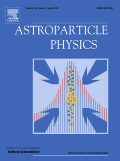
ASTROPARTICLE PHYSICS
Bridging the Gap Between Cosmic Discoveries and Particle ScienceASTROPARTICLE PHYSICS is a premier international journal dedicated to advancing the understanding of the intersection between particle physics, astronomy, and astrophysics. Published by Elsevier, this journal has established itself as a leading source of research insights since its inception in 1992, with a remarkable impact factor positioning it within the Q1 category for Astronomy and Astrophysics for 2023. With a Scopus ranking of 18 out of 90 in its field, representing the top 80th percentile, ASTROPARTICLE PHYSICS serves as an essential platform for disseminating groundbreaking research that influences astrophysical studies and cosmological theories. Researchers and academics have access to a robust collection of peer-reviewed articles that explore various dimensions of astroparticle phenomena, collaborative cosmic investigations, and theoretical advancements. Although not an open-access journal, it provides extensive research coverage accessible to a global audience from its headquarters in Amsterdam, Netherlands, offering a vital resource for those seeking to push the boundaries of knowledge in the realms of astrophysics and particle physics.
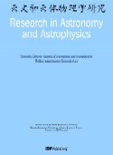
Research in Astronomy and Astrophysics
Connecting Minds Across the Celestial Realm.Research in Astronomy and Astrophysics, published by the National Astronomical Observatories under the Chinese Academy of Sciences, stands out as a pivotal platform for disseminating cutting-edge research in the fields of astronomy and astrophysics. With an ISSN of 1674-4527 and an E-ISSN of 2397-6209, this esteemed journal operates as an open access publication, ensuring that high-quality research is available to a broad audience without any financial barriers. As of 2023, it holds a commendable Q2 quartile ranking in both Astronomy and Astrophysics, as well as Space and Planetary Science, reflecting its importance and revered position among leading journals. Spanning from 2009 to 2024, it is geographically rooted in the United Kingdom but engages a global readership and author base, making significant contributions to the rapidly evolving discourse in astrophysical studies. Moreover, its rankings in Scopus underscore its relevance, ranking 43rd out of 90 in Astronomy and Astrophysics and 61st out of 104 in Space and Planetary Science, placing it firmly within the competitive landscape of scientific research. Research in Astronomy and Astrophysics is dedicated to fostering innovation and communication within the scientific community, offering researchers, professionals, and students alike a valuable resource for collaboration and knowledge advancement.
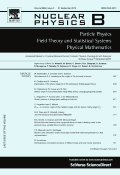
NUCLEAR PHYSICS B
Catalyzing Breakthroughs in High Energy PhysicsNUCLEAR PHYSICS B, published by Elsevier, stands at the forefront of research in the dynamic field of Nuclear and High Energy Physics. Established in 1967, this prestigious journal has developed a reputation for excellence, now positioned in the Q1 category according to its 2023 quartile rankings. With an impressive Scopus rank of #21 out of 87 in its category and a commendable 76th percentile, it serves as a vital resource for scholars investigating the underlying principles of nuclear interactions and particle physics. The journal transitioned to an Open Access model in 2014, ensuring that groundbreaking research is accessible to a global audience. Its commitment to quality and innovation makes NUCLEAR PHYSICS B an essential platform for researchers, professionals, and students aiming to stay at the cutting edge of discoveries in this expansive field, contributing to the scientific discourse for nearly six decades.

Science China-Physics Mechanics & Astronomy
Pioneering Research in Fundamental and Applied PhysicsScience China-Physics Mechanics & Astronomy, published by SCIENCE PRESS, stands as a prestigious journal within the Physics and Astronomy domain, particularly recognized for its contributions to the understanding of fundamental and applied physics. With an exhilarating Q1 ranking in the 2023 category and earning a remarkable scopus rank of #21 out of 243, the journal demonstrates its significant impact, being positioned in the 91st percentile of its field. Operating under an Open Access model, it facilitates the broad dissemination of high-quality research, ensuring accessibility for researchers, professionals, and students worldwide. Its scope covers a variety of essential topics in physics and astronomy, promoting a comprehensive understanding of the latest advancements from 2010 through 2024. The journal is a vital resource for anyone aiming to stay at the forefront of research in these dynamic fields, with its prominent address located in Beijing, China, symbolizing its global influence.
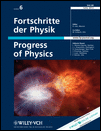
FORTSCHRITTE DER PHYSIK-PROGRESS OF PHYSICS
Unveiling Breakthroughs in Physics and AstronomyFORTSCHRITTE DER PHYSIK-PROGRESS OF PHYSICS, published by WILEY-V C H VERLAG GMBH, is a prestigious academic journal esteemed within the field of physics. With a history spanning over seven decades since its inception in 1953 and a converged publication up until 2024, this journal has established itself as a leading source for groundbreaking research and developments across diverse domains in physics and astronomy. Holding an influential Q1 ranking in the 2023 category of Physics and Astronomy (miscellaneous), it serves as an essential platform for disseminating high-quality research findings and theoretical advancements. Although not an Open Access publication, FORTSCHRITTE DER PHYSIK provides access to critical insights and scholarly discussions that are pivotal for researchers, professionals, and students alike. The journal is committed to contributing to the evolution of knowledge in physics, supporting the academic community through rigorous peer-reviewed articles, reviews, and innovative studies.

Physics of the Dark Universe
Decoding the Secrets of Dark Energy and MatterPhysics of the Dark Universe is a premier academic journal published by Elsevier, dedicated to advancing the understanding of dark matter, dark energy, and their implications for the universe. With its ISSN N/A and E-ISSN 2212-6864, the journal has established a notable presence since its inception in 2012, operating out of Amsterdam, Netherlands. As evidenced by its impressive impact factor and its ranking in the top quartile in both Astronomy and Astrophysics (Q1) and Space and Planetary Science (Q1) categories for 2023, this journal is a vital resource for researchers and practitioners within these fields. In the latest Scopus ranks, it ranks #12 out of 104 in Earth and Planetary Sciences and #13 out of 90 in Physics and Astronomy, placing it in the 88th and 86th percentiles respectively, underlining its academic significance. The journal is not Open Access, yet it plays an essential role in disseminating high-quality research that pushes the boundaries of knowledge about the cosmos and its most enigmatic components. Researchers, professionals, and students interested in the forefront of astrophysics will find this journal an indispensable tool for staying abreast of emerging discoveries and ongoing debates.

INTERNATIONAL JOURNAL OF MODERN PHYSICS A
Elevating research standards in contemporary physics.INTERNATIONAL JOURNAL OF MODERN PHYSICS A, published by WORLD SCIENTIFIC PUBL CO PTE LTD, stands as a pivotal platform in advancing the frontiers of research within the fields of Astronomy and Astrophysics, Atomic and Molecular Physics, and Nuclear and High Energy Physics. Established in 1989, this journal has systematically contributed to the scientific community, with a demonstrated impact as indicated by its Q2 category rankings across these critical disciplines in 2023. Researchers and professionals are encouraged to engage with its rigorous peer-reviewed content, fostering a deeper understanding of modern physics theories and experimental breakthroughs. Although the journal operates under a conventional access model, it remains a vital resource for those seeking to disseminate their findings and stay abreast of cutting-edge developments. With an emphasis on quality and breadth of research, the journal continues to attract submissions from leading physicists and scholars, enhancing its reputation as a key academic resource.
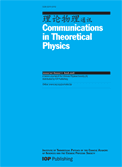
COMMUNICATIONS IN THEORETICAL PHYSICS
Pioneering research for a deeper understanding of physical laws.COMMUNICATIONS IN THEORETICAL PHYSICS is a distinguished journal published by IOP Publishing Ltd, focusing on the broad and evolving field of theoretical physics. With an ISSN of 0253-6102 and an E-ISSN of 1572-9494, this journal provides a platform for the dissemination of innovative research that contributes to the understanding of complex physical concepts. Situated in the United Kingdom, it has established itself as a pivotal resource from 1996 to 2024, achieving a commendable Q2 ranking in the category of Physics and Astronomy (miscellaneous) for 2023. With a Scopus ranking of #18 out of 81 in its category, demonstrating a 78th percentile, this journal plays a crucial role in enhancing scholarly communication among researchers, professionals, and students alike. Although it does not currently offer Open Access options, the journal's comprehensive scope and commitment to high-quality peer-reviewed research underline its significance in the scientific community, making it an essential reading for anyone engaged in theoretical physics.

Universe
Pioneering Open Access in the Study of the Universe.Universe is a distinguished peer-reviewed journal published by MDPI, specializing in the dynamic fields of Physics and Astronomy. Established in 2015, this Open Access journal has rapidly gained recognition, achieving a prestigious Q1 quartile ranking in its category as of 2023. With its E-ISSN 2218-1997, the journal primarily serves the international scientific community, offering a platform for researchers to disseminate innovative ideas and findings. Based in Switzerland, Universe covers a wide range of topics within astronomy and astrophysics, ensuring that cutting-edge research is accessible to an ever-growing audience. Its commitment to open access principles since its inception allows for unrestricted dissemination of knowledge, fostering a collaborative environment essential for scientific advancement. By aligning its objectives with the promotion of high-quality research and interdisciplinary discourse, Universe stands as a vital resource for academics, professionals, and students aiming to contribute to and engage with the ever-evolving landscape of astronomical research.

ASTROPHYSICS
Navigating Cosmic Frontiers: Your Guide to Astrophysical DiscoveryASTROPHYSICS, published by Springer/Plenum Publishers, stands as a crucial platform for the dissemination of groundbreaking research in the field of Astronomy and Astrophysics. Established in 1965 and continuing its legacy until 2024, the journal highlights significant advancements, theoretical frameworks, and observational data that collectively push the boundaries of our understanding of the universe. Although currently categorized in the Q4 quartile for Astronomy and Astrophysics and holding a Scopus rank within the 17th percentile, ASTROPHYSICS remains dedicated to offering rigorous peer-reviewed content that is essential for researchers, professionals, and students alike. While it does not provide open access, the journal's accessibility through institutional subscriptions ensures a wide reach among the academic community, allowing it to address the rising curiosity surrounding cosmic phenomena and contribute meaningfully to ongoing scholarly discourse. For those seeking to engage with the latest findings and methodologies in astrophysics, ASTROPHYSICS continues to serve as an indispensable resource.